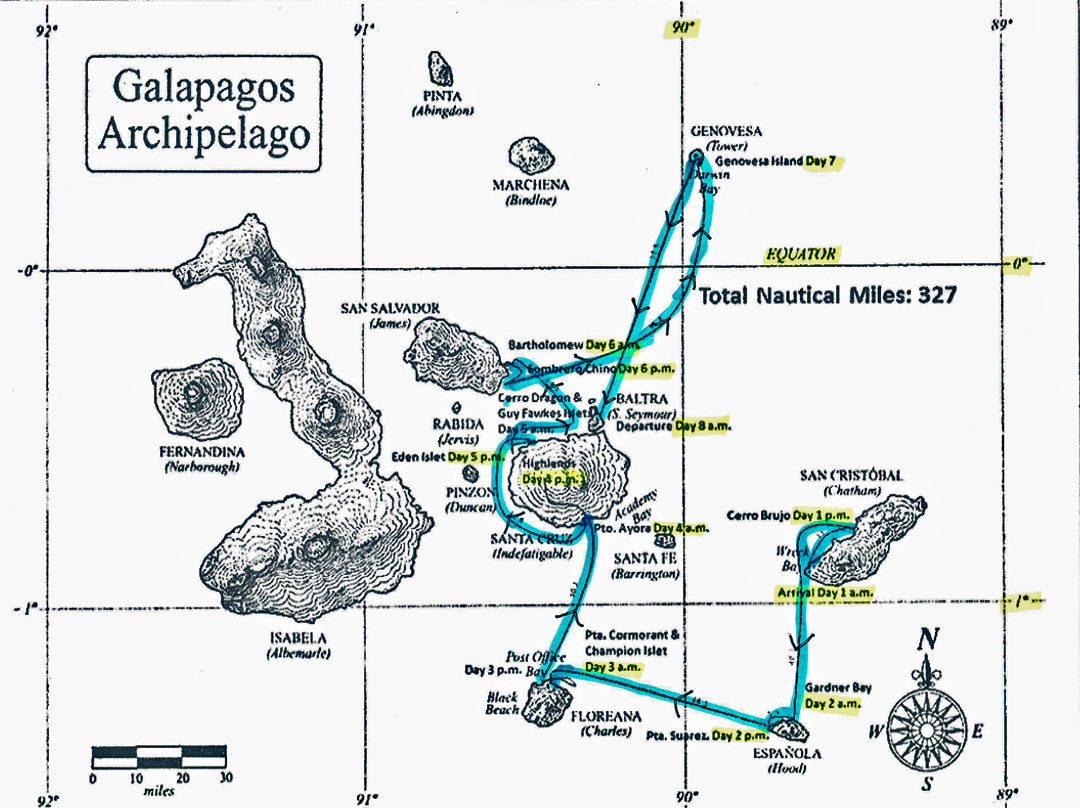|
Home
I cruised the Galapagos
Islands with Lindblad Expeditions on the National Geographic Endeavour from May 12 through May 19, 2012. The Galapagos
Islands are a National Park controlled by the country of Ecuador. Which islands that can be visited is staggered to
avoid overuse. No one is allowed unless accompanied by the licensed guide. Although there were other groups touring
the islands, we never encountered them on any of the islands. My tour was a National Geographic Tour. The National
Geographic Society has played a large role in the conservation of the islands and is granted special privileges for
tours. We were restricted from approaching closer than 6 feet any bird or animal. Many times we had to
back up to stay that distance. They came to us!
| Note that there are 3 airports in the Galapagos. |
 |
| These islands are inhabited. The rest are uninhabited. |
The population of these three inhabited islands with airports
and roads is reaching 30,000. Population controls are in place that only allow those who were born in there Galapagos
Islands to live there or those that marry an eligible resident.
 |
| This where I went |
If you look at the contour lines it becomes obvious
that the Galapagos are volcanic in origin
The primary enemy of the Galapagos is man and his imported plants and animals.
The land tortoise population was almost decimated by whaling ships.
They found that the tortoise could survive for months without food or
water and made tasty meals far out to sea. Early settlers brought
cats, dogs, pigs, donkeys, cattle and goats as well as rats to the islands.
These invasive animals nearly caused the extinction of many of the
plants and animals indigenous to the islands. And may have totally
destroyed some that we never knew about.
A massive extermination program has freed most of the uninhabited
islands from these threats, largely with assistance from the National
Geographic Society and the Darwin Conservation Society.
The primary enemy of the Galapagos is man and his imported plants and animals.
The land tortoise population was almost decimated by whaling ships.
They found that the tortoise could survive for months without food or
water and made tasty meals far out to sea. Early settlers brought
cats, dogs, pigs, donkeys, cattle and goats as well as rats to the islands.
These invasive animals nearly caused the extinction of many of the
plants and animals indigenous to the islands. And may have totally
destroyed some that we never knew about.
A massive extermination program has freed most of the uninhabited
islands from these threats, largely with assistance from the National
Geographic Society and the Darwin Conservation Society.
|
|||||||||
| National Geographic ENDEAVOUR - My Ship | |||||||||
This is where I went and what I went on. There were 95 others that shared this experience
with me. Two of which had also shared my safari to South Africa earlier. Look for those photos elsewhere in this
website.
I requested to share a cabin to save the "singles fee" but luckily there was no one else available to share so I ended up with a cabin all to myself.
All photos were taken by me using a Nikon D300, a Canon SX20iS or a Lumix DMC-TS3 unless noted as a "file" photo. Such photos were taken by others on the expedition or from web sites and they retain all copyrights thereto.
I did learn one thing on this expedition. Never use cheap filters on your camera. I ruined many great photos because I had cheap circular polarizing filters. It kept the auto focus from working properly. You will notice on many of the photos that the focus is blurry. Why, a cheap CP filter! Needless to say, these cheap Tiffin CP filters are now resident in the sanitary fill and I have Hoya and B+W CP filters for when I need them.
I requested to share a cabin to save the "singles fee" but luckily there was no one else available to share so I ended up with a cabin all to myself.
All photos were taken by me using a Nikon D300, a Canon SX20iS or a Lumix DMC-TS3 unless noted as a "file" photo. Such photos were taken by others on the expedition or from web sites and they retain all copyrights thereto.
I did learn one thing on this expedition. Never use cheap filters on your camera. I ruined many great photos because I had cheap circular polarizing filters. It kept the auto focus from working properly. You will notice on many of the photos that the focus is blurry. Why, a cheap CP filter! Needless to say, these cheap Tiffin CP filters are now resident in the sanitary fill and I have Hoya and B+W CP filters for when I need them.
The photos on the next pages are not in any specific order as to date. I have grouped them as to subject matter.
